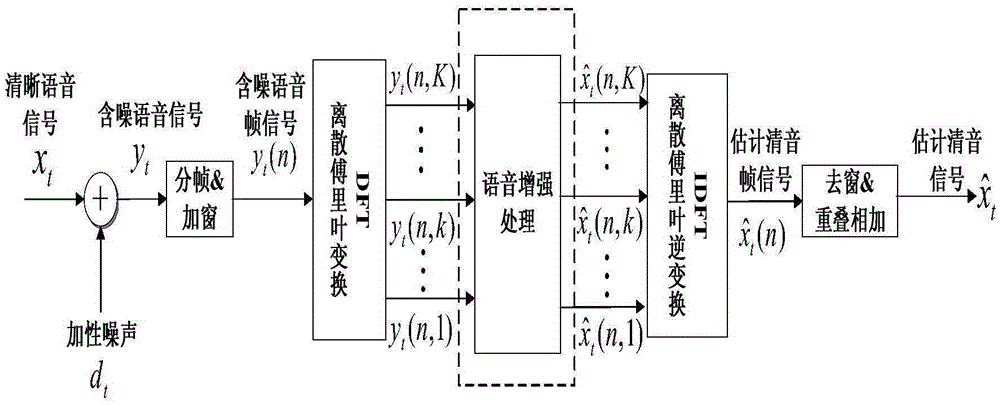Prior signal-to-noise ratio estimating method based on MMSE error criterion
A priori signal-to-noise ratio and criterion technology, applied in speech analysis, instruments, etc., can solve problems such as dialogue and communication process interference, hearing fatigue of dialogue listeners, damage to the auditory quality and acoustic characteristics of voice signals, etc.
- Summary
- Abstract
- Description
- Claims
- Application Information
AI Technical Summary
Problems solved by technology
Method used
Image
Examples
Embodiment Construction
[0034] The present invention will be further elaborated below in conjunction with the accompanying drawings.
[0035] like figure 1 As shown, the noisy speech signal y t After framing and windowing processing, the noisy speech frame signal y is obtained t (n), noisy speech frame signal y t (n) After discrete Fourier transform, the magnitude spectrum value y of the kth frequency component of the nth frame of the noisy speech is obtained t (n, k), after the amplitude spectrum value is through the operation of the speech enhancement processing module, output the estimated value of the kth frequency unvoiced sound amplitude spectrum of the nth frame Estimated value of the unvoiced amplitude spectrum at the kth frequency of the nth frame After the inverse discrete Fourier transform, the estimated unvoiced frame signal is obtained After the frame signal is processed by window removal and overlap and addition, the estimated unvoiced signal is output
[0036] The specific i...
PUM
 Login to View More
Login to View More Abstract
Description
Claims
Application Information
 Login to View More
Login to View More - R&D
- Intellectual Property
- Life Sciences
- Materials
- Tech Scout
- Unparalleled Data Quality
- Higher Quality Content
- 60% Fewer Hallucinations
Browse by: Latest US Patents, China's latest patents, Technical Efficacy Thesaurus, Application Domain, Technology Topic, Popular Technical Reports.
© 2025 PatSnap. All rights reserved.Legal|Privacy policy|Modern Slavery Act Transparency Statement|Sitemap|About US| Contact US: help@patsnap.com



